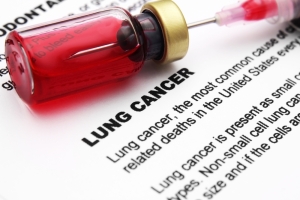When the “extent of disease evaluation” is done, the oncologist can discuss with the patient and the family what stage the lung cancer is in and what the chances of survival for the lung cancer are based on a vast amount of knowledge.
Treatment options can now be discussed in detail and the therapy can be tailored to the needs of the patient. In principal, stage I and II are approached mainly surgically to remove all cancer within the healthy surrounding tissue.
In the hands of an oncological surgeon or thoracic surgeon this kind of surgery has only a mortality of 1% to 8% (lower risk in younger patients, higher risk in patients above 75 years of age). With surgery the higher survival rates indicated in the table above can be achieved (up to 80 % in stage I, up to 50% in stage II).
Stage IIIA can be managed surgically, but stage IIIB needs another approach. Usually with this stage as well as with stage IV radiotherapy and combination chemotherapy are needed, but the exact details would be beyond the scope of this summary. Also, every person is different. A lot depends on the exact location, the stage at the time of diagnosis and even the cell type of the lung cancer regarding the treatment. Unfortunately the response rates in this late stage are poor and even a prolongation of life by 4 months is considered a “good” response.
However, since May of 2001 there is a “new kid on the block”, a selective tyrosine kinase inhibitor, which may be beneficial in up to 70% of all small cell lung cancers (Ref. 4). It is now approved by the FDA for chronic CML leukemia, but has been found in pilot studies to also be effective in small cell lung cancer (Ref. 5 and 6). This is good news for a significant number of patients. The name of the medication is Gleevec. This new medication likely will improve the survival data for stage III and IV, but clinical trials have to be done first.
References:
1. Cancer: Principles &Practice of Oncology, 4th edition, volume 1. Edited by V.T. De Vita,Jr.,et. al J.B. LippincottCo.,Philadelphia, 1993.Chapter on lung cancer.
2. Cancer: Principles&Practice of Oncology. 5th edition, volume 1. Edited by Vincent T. DeVita, Jr. et al. Lippincott-Raven Publ., Philadelphia,PA, 1997. Chapter on lung cancer.
3. The Merck Manual, 7th edition, by M. H. Beers et al., Whitehouse Station, N.J., 1999. Chapter 81: Tumors of the lung.
4. GW Krystal et al. Clin Cancer Res 2000 Aug;6(8):3319-3326.
5. BJ Druker et al. N Engl J Med 2001 Apr 5;344(14):1031-1037.
6. MJ Mauro et al. Curr Oncol Rep 2001 May;3(3):223-227.
7. Conn’s Current Therapy 2004, 56th ed., Copyright © 2004 Elsevier
8. Ferri: Ferri’s Clinical Advisor: Instant Diagnosis and Treatment, 2004 ed., Copyright © 2004 Mosby, Inc
9. Suzanne Somers: “Breakthrough” Eight Steps to Wellness– Life-altering Secrets from Today’s Cutting-edge Doctors”, Crown Publishers, 2008







